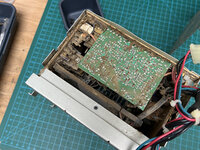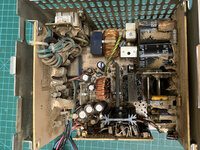jmacz
Well-known member
Took delivery on a Quadra 800 this week. This thread will document my process of cleaning it up and adding it to my fleet.
The unit was in ok condition upon visual inspection. The outer case was yellowed but still intact. Two of the front drive bay bezels had broken clips and were taped on. The thing had so much dirt inside, it's quite possibly this was stored in an extremely dusty environment. It wasn't just dust but it was fine dirt. There were even some broken leaves inside. First thing was to take it apart and get the motherboard out of there.
The board was actually in very good shape. The original battery was there and had leaked but it was contained to the battery holder luckily. After cleaning the board, I hooked it up to my bench power supply and powered the board. It chimed and got the disk icon. Great! I hooked up a ZuluSCSI Mini to it and it booted immediately without issues. That's great news.
I removed the heat sink, put new thermal paste on, and then reinstalled it.
I then removed the floppy (caked with dirt), the CD-ROM drive (actually looked ok but will need to open it up to check for leaking caps), the power supply... ugh, it had so much dirt inside...

The above was after vacuuming. I then got the outer case off and took a look inside. More dirt. And again after some vacuuming, this is what it still looked like:

Really gross. I will need to take it out tomorrow and use an air compressor to get this dust out... will use really low PSI to ensure I don't shove more dirt into places where it should not go.
But taking a quick peak, it's dirty, but seems ok? I don't see any bulging or leaking caps. This is Delta made unit and I've heard those have lasted longer than the Astec or GE ones (well, at least this was the case in my IIci's). I will clean up the PSU and if it works, I'm going to leave it alone for now. There are some caps in locations that I cannot get to without taking all three vertical boards off the main board, and there are a lot of connections so I don't want to deal with it.
The PSU fan measures 120mm x 120mm x 38mm. It's a 12V. I know folks tend to keep the fans. I just want it quieter. I'm not going to tax the unit. So I will replace it if I can.
That's all for now. The tasks I intend for this Quadra 800:
The unit was in ok condition upon visual inspection. The outer case was yellowed but still intact. Two of the front drive bay bezels had broken clips and were taped on. The thing had so much dirt inside, it's quite possibly this was stored in an extremely dusty environment. It wasn't just dust but it was fine dirt. There were even some broken leaves inside. First thing was to take it apart and get the motherboard out of there.
The board was actually in very good shape. The original battery was there and had leaked but it was contained to the battery holder luckily. After cleaning the board, I hooked it up to my bench power supply and powered the board. It chimed and got the disk icon. Great! I hooked up a ZuluSCSI Mini to it and it booted immediately without issues. That's great news.
I removed the heat sink, put new thermal paste on, and then reinstalled it.
I then removed the floppy (caked with dirt), the CD-ROM drive (actually looked ok but will need to open it up to check for leaking caps), the power supply... ugh, it had so much dirt inside...

The above was after vacuuming. I then got the outer case off and took a look inside. More dirt. And again after some vacuuming, this is what it still looked like:

Really gross. I will need to take it out tomorrow and use an air compressor to get this dust out... will use really low PSI to ensure I don't shove more dirt into places where it should not go.
But taking a quick peak, it's dirty, but seems ok? I don't see any bulging or leaking caps. This is Delta made unit and I've heard those have lasted longer than the Astec or GE ones (well, at least this was the case in my IIci's). I will clean up the PSU and if it works, I'm going to leave it alone for now. There are some caps in locations that I cannot get to without taking all three vertical boards off the main board, and there are a lot of connections so I don't want to deal with it.
The PSU fan measures 120mm x 120mm x 38mm. It's a 12V. I know folks tend to keep the fans. I just want it quieter. I'm not going to tax the unit. So I will replace it if I can.
That's all for now. The tasks I intend for this Quadra 800:
- Recap the CD-ROM drive.
- Check if the floppy drive works and clean / lube it, replace the eject gear.
- Fix the front drive bay bezels (I've already done this - designed and 3D printed new clips/hinges for it).
- Install a 640MB magento optical drive to make it easier to share files with my IIfx.
- ZuluSCSI for the main disk.
- New rear slot cover to allow ZuluSCSI card access.
- Needs new feet.
- Clean up the exterior.


